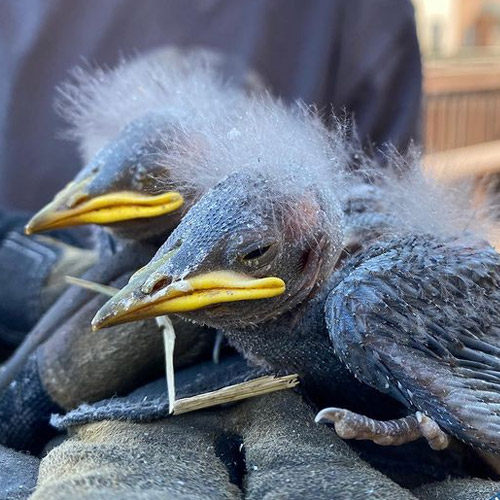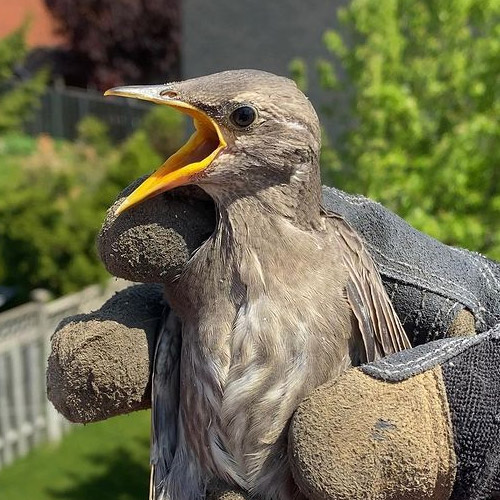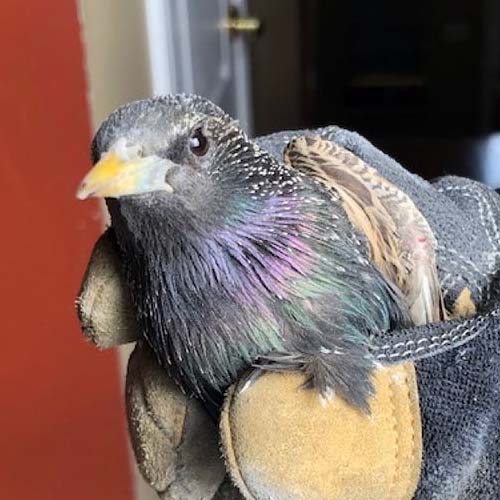Home / Wildlife Control Services in Vancouver / Starling Faqs
Starling Faqs
The following are some common starling questions that our customers ask us:
Do Starlings nest in vents?
Dryer, stove, and bathroom vents are ideal nesting spots for Starlings. A vent with a metal flap may not deter them as Starlings can hover or perch while raising the flap to get into vents. If you have Starlings nesting in your vent, please contact a professional to safely and humanely remove the nest.
Can Starlings nest in walls?
Yes, Starlings will nest in any cavity they can gain access to. It’s also not uncommon for young to fall out of nests and get trapped between walls. If you hear bird chirping in your wall, please contact a professional to safely and humanely remove a starling that may be trapped.
Can Starlings nests be moved?
If there is a Starling nest in a vent, attic or wall that you need to remove, please contact a professional. You can move a starling nest but it must be done carefully to ensure the eggs or chicks survive being moved and that it is doen as humanely as possible.
I have been told that starlings will leave my attic on their own after a few weeks weeks. Is that true?
It is not uncommon for nests to be reused by the same family or a different family or species in the future. It takes trained technicians to identify starlings nests and remove then using humane, hands-on techniques.

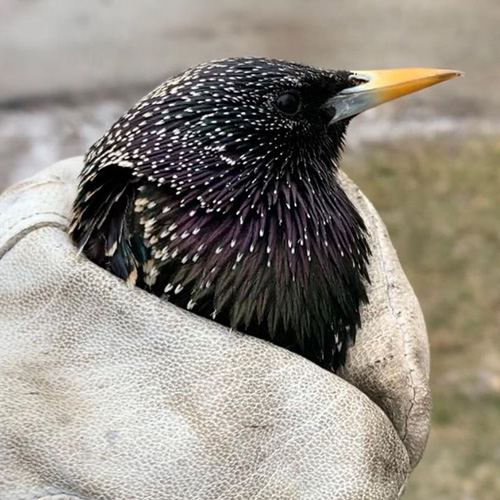
We only see one bird going in and out of our attic so there are probably no babies, right?
Not necessarily. Babies can remain in the nest for a period while the mother locates and returns with food. Babies will leave the nest when they are ready to fly.
I’ve been told that you have to catch the starlings and relocate then far away from your house otherwise they will get back in. Is that true?
No. Following our humane removal procedure, we install professional bird proofing in all possible entry points. The starlings will not be able to get back in – we guarantee it! In fact, if a bird does manage to get back into your home, we will return and complete a second remediation for free.
How do I know if I have starlings in my home or building?
Starlings are usually very noisy and are not very discrete. Babies will be very vocal when calling for food from their mother. And you will be able to see the mother starlings coming and going with food and may even be able to see the open mouths of the babies. Starling droppings are also easy to spot on concentrations around nests and entry points.
Food and Feeding
They eat a variety of substances but prefer insects they can pull out of lawns and grassy fields. When feeding, they tend to flock with birds in the front frequently shifting to the back in a rolling pattern.
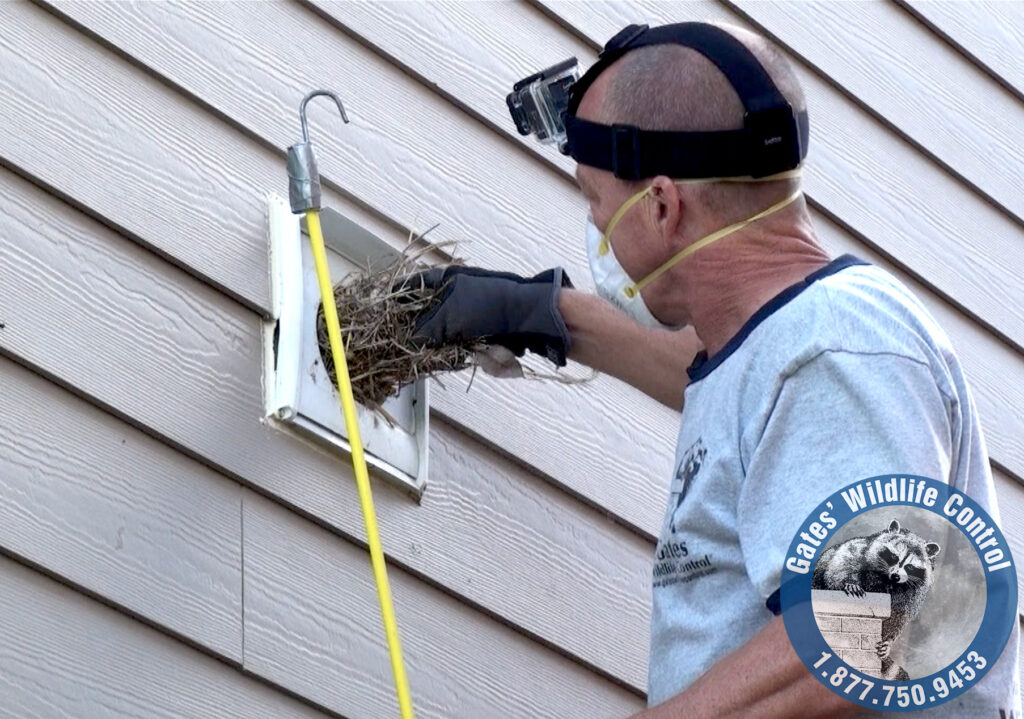
Morphology and Lifestyle
- Length: 15 – 30 centimeters depending on species
- Weight: 34 – 225 grams
- Calls: Varied – can emit a “wolf whistle” like sound along with various whistling notes and chatter
- Lifespan: About three years on average
Did You Know?
- Starling fact: Starlings are very aggressive!
- Starling fact: Slippery droppings pose safety risks in populated areas.
- Starling fact: Starlings compete for resources with native, cavity-nesting birds like purple martins, bluebirds and flickers.
39 Years Of Wildlife Removal Experience
At Gates Wildlife Control, we offer professional and effective animal removal and prevention solutions to keep raccoons, squirrels, and skunks from entering your home. We also provide effective rodent control services for mice and rat infestations. Our team is trained and experienced in the installation of one-way doors, which allow the animals to exit your attic or walls, but prevent them from returning. Contact us today for a free consultation and quote,to keep these animals out of your home for good.
Raccoons, squirrels, and skunks are common animals that can cause damage and create nuisances when they move into your attic or walls. They can chew on wires, damage insulation, leave droppings and debris, and even carry diseases and parasites.
One-way doors are a humane and effective way to remove these animals from your home and prevent them from returning. The doors are installed over the entry points the animals are using to access your attic or walls. Once the animals leave to forage for food, they are unable to re-enter the space through the one-way door.
At Gates Wildlife Control, we have the knowledge and equipment to effectively install one-way doors for raccoons, squirrels, and skunks. Our team will also assess your home and identify any potential entry points that need to be sealed off to prevent future intrusions.
In addition to installing one-way doors, we also offer repair services for damage caused by the animals and provide screening of potential entry points. This includes fixing holes in the roof or walls to prevent water from coming into the roof and walls and installing screens over roof vents, soffits and chimneys.
Don’t let raccoons, squirrels, or skunks take over your attic or walls. Contact Gates Wildlife Control today for a free consultation and quote, and keep these pests out of your home for good with our one-way door installation services.

Morphology and Lifestyle
- Wing span: Big Brown Bats – 32 to 39cm; Little Brown Bats – 22 to 27cm.
- Weight: Big Brown Bats – 11 to 25g; Little Brown Bats – 5 to 11g.
- Vocalization: Bats use high frequency echo-location that is hard to hear with the exception of some clicking sounds.
- Lifespan: Between 10 and 20 years with the rare bat living as long as 30 years.
Did You Know?
- Bat fact: Bats play an important role in our environment as they can consume up to 3,000 insects in one night.
- Bat fact: Bats in Canada will not fly in your hair and suck your blood.
- Bat fact: Bats can spread the rabies virus when infected with very little to no evidence of contact.
- Bat fact: Bats can squeeze through a hole the size of a dime.
- Bat fact: A bat can produce several times its own weight in waste each month.
- Bat fact: Bat colonies can range in size from one to several hundred and can double in size every year.
- Bat fact: Bats hibernate when the temperature drops below 10 degrees C.
More About Starling

Humane Raccoon Removal

Humane Skunk Removal

Humane Squirrel Removal
Do It Yourself Dangers
For those who may be tempted to take on the task of removing animals and animal proofing themselves, it is important to remember that it can be a dangerous undertaking. Falling off ladders and roofs while attempting to remove animals or seal entry points can result in serious bodily harm. In some cases, even aggressive animals can pose a danger to those trying to remove them. It is best to leave these tasks to experienced professionals who have the knowledge and equipment to safely and effectively handle wildlife removal and animal proofing. Attempting to do it yourself can put you at risk of injury and potentially even more damage to your home.


















